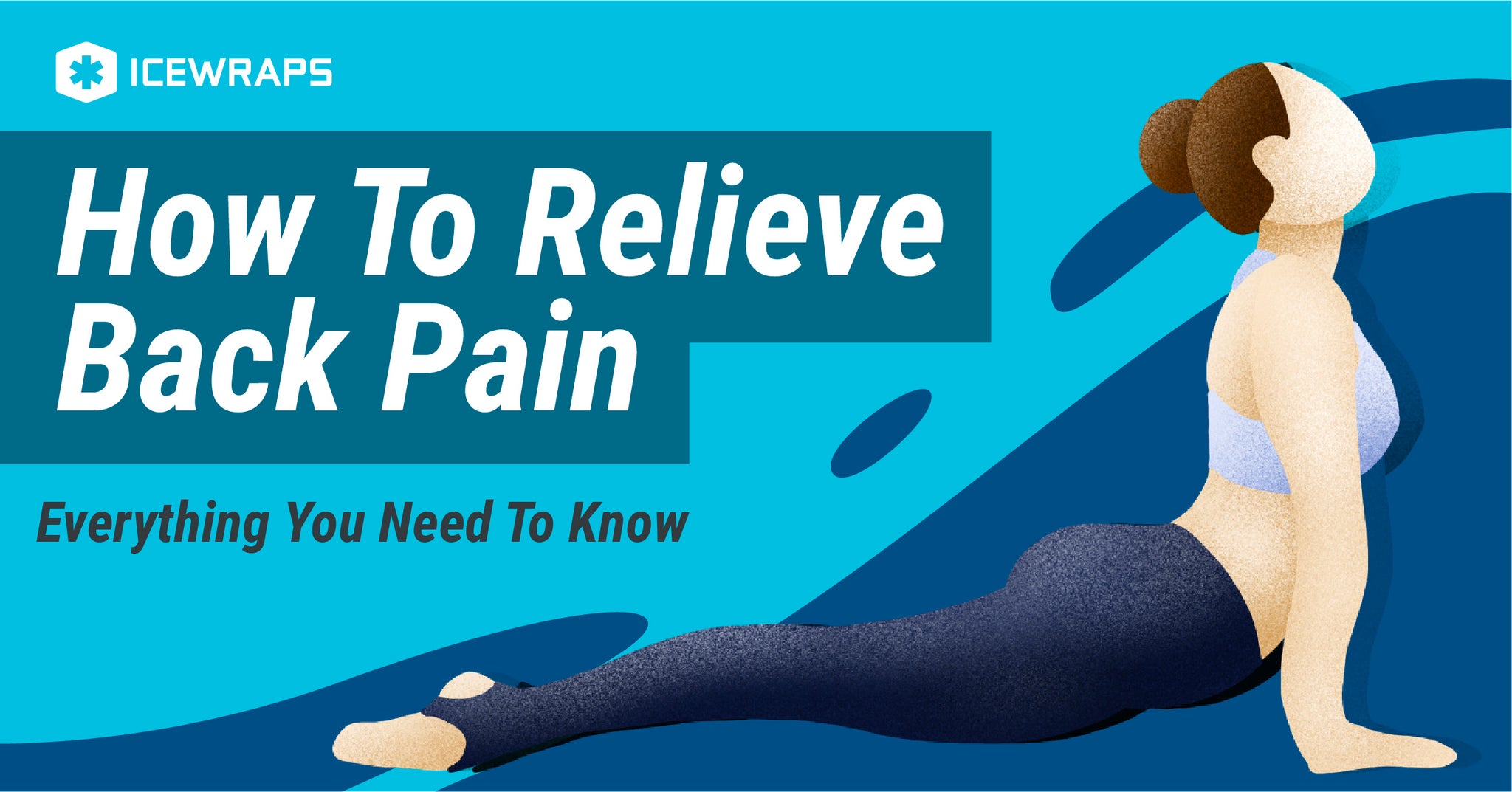Your Cart is Empty

Contents
If you have ever had back pain, then you know how the condition can make moving around difficult. Back pain can limit your ability to sit, stand, walk, or enjoy normal work and recreational activities.
Back pain, and the symptoms that may be associated with it, doesn't have to limit your lifestyle. There are some simple things you can do to treat your back pain and get back to your normal lifestyle quickly and safely. And the most important treatment for back pain is learning what to do in order to keep it away.
Back pain affects nearly everyone at one time or another, and it is the second leading cause of a visit to your doctor. Back pain accounts for a significant amount of lost time at work, and it can also prevent you from simply enjoying sports or other recreational activities.
There are some characteristics of people who get back pain. These include:
Even if you are an active person who doesn't smoke, you may experience back pain at one time or another. Learning what to do when your pain strikes and how to prevent episodes of pain is the key to effective management.
To effectively manage your back pain, it helps to have a basic understanding of the anatomy of your spine.
Your low back, or lumbar spine, is composed of 5 vertebrae, conveniently labeled lumbar 1-5. In the proper anatomical position, there should be a forward curve in your low back called a lordosis. This position of your back helps to keep your joints, muscles, and spinal discs in alignment.
Your spine is comprised of several bones called vertebrae that are stacked upon one another. Between the vertebrae are soft, spongy shock absorbers called discs. Your spinal vertebrae protect your spinal cord and nerves. The spinal nerves send signals from your brain to your body or your body to your brain.
At each level in your spine, there are joints where two vertebrae articulate with one another. Several ligaments connect these vertebrae to one another, and various muscles attach to your spine. These muscles help to move your back and provide support for your trunk and core.
There are many different causes of low back pain or sciatica. Sometimes the cause of your specific problem may be obvious--trauma to your back in a motor vehicle accident or a fall may be the cause of your pain. Other times, your back pain may seem to come on for no apparent reason.
The most common reasons that people get low back pain or sciatic include:
All of these reasons may cause some sort of strain to your spinal bones, discs, muscles or joints. This may lead to pain-causing problems such as arthritis, muscle strains, or bulging and herniated discs. These problems may compress spinal nerves, sending pain into your buttocks, thighs, or legs.
If you are dealing with spinal problems, there are different places on your body where you may feel symptoms. In your low back, you may feel symptoms in various places including:
Neck pain may cause similar symptoms, but the pain is felt in your neck, shoulder blades, or down one or both arms.
Sometimes back pain or sciatica may be accompanied by changes in your bowel or bladder habits. Inability to control bowel movements or difficulty initiating urination are a sign that you need to see your doctor or visit the emergency room right away.
If you are experiencing pain in your neck, back, or arms and legs, you should check in with your doctor to get on the right track with treatment. Early access to treatment can help you find fast relief for your back pain.
When low back pain strikes, it is important to see your doctor. He or she can help you get a definitive diagnosis for your condition. Caution should be used--some back pain cannot be accurately diagnosed, even with advanced diagnostic imaging.
Common diagnostic tests for low back pain may include:
When you have a diagnostic test such as an x-ray or MRI, your doctor is looking for specific anatomical pathologies that may be causing your pain. Some tests show boney anatomy, while others show soft tissue like muscles or intervertebral discs. You may have a test done that shows multiple problems with your back or neck. Other tests may show very little pathology with your spine. This is what makes getting an accurate diagnosis for your pain difficult; diagnostic tests are very sensitive, but not very specific to your condition.
If you do have an accurate diagnosis, treatment can begin for your back pain. Even without advanced diagnostic tests, you can do some things to start caring for your back pain right away.
When back pain strikes, it is helpful to get started on treatment right away. The quicker you can get moving, the easier it will be to return to normal.
Some things you can do to start on the road to recovery may include:
1. Using ice to control inflammation and pain. When back pain or sciatica first strikes, it is a good idea to control the inflammation that occurs. Using ice when your pain is acute can help limit blood flow to your back muscles. This decrease in blood flow will help to limit swelling of muscle tissues and can help reduce the pain that you are feeling.
Some ice products like the Pro Ice Multi-Purpose Cold Therapy Ice Wrap can provide coverage to a large area and are perfectly suited for your back.
Some experts recommend using a back ice wrap that provides firm compression to help stabilize your back during the acute phase of healing. The PolyGel ThermoActive Back Support allows you to use ice with firm support. This is done with a hand-held pump that gives you control over the amount of compression to use while icing.
Ice is typically used for the first 24 to 48 hours after onset of symptoms. Each time you use ice, you should use it for 20 to 30 minutes, and it can be applied several times per day. Be sure to check your skin while icing to ensure that you are not suffering from freezer burn or frostbite.
2. Using heat to improve local blood flow to your back muscles. After icing for a few days, it may be time to switch to using heat for your backache. Why? Because heat causes vasodilation, an opening of blood vessels. This increases circulation to your back, helping to bring in fresh oxygen and nutrients to your injured tissues while washing away metabolic waste.
Many rehab professionals recommend using moist heat for your back. The Chattanooga Automatic Moist Heat Pack is the perfect therapy tool for your back. It allows you to use moist heat and dial in the temperature, so you get an individualized heating session for your back every time you use it.
You may be able to use your ice pack as a heat pack for your back. The PolyGel ThermoActive Back Support can be used as either an ice pack or heat wrap. Another heat wrap, the ActiveWrap Cold/Hot Therapy Wrap may be the perfect therapy device for you, offering both heat and compression in an easy to use wrap.
You should use heat for 20 to 30 minutes several times per day, taking care not to burn your skin during heat application. It is best to check in with your doctor when back pain strikes; he or she can help guide you in using heat or ice for your condition.
 |
| ICEWRAPS 12X21 OVERSIZE COLD THERAPY CLAY PACK WITH COVER |
 |
3. Starting a physical therapy program. Studies show that starting an active physical therapy program can save you time and money in caring for your back. Your physical therapist can show you exercises to do that can help improve your back's range of motion and strength. Your PT can also teach you things to do to prevent future episodes of back pain.
4. Visiting a chiropractor. Some people benefit from chiropractic manipulation for their back aches and pains. Spinal manipulation should only be done by a licensed chiropractor and should not the only treatment you get; your chiropractor should also teach you how to manage your back pain independently with exercise and postural changes.
5. Maintaining proper posture. Studies indicate that poor sitting posture may be a cause of back pain. Slouched sitting can place increased stress and strain on your spinal discs and joints, leading to back pain or sciatica. Sitting upright can keep your spine in proper alignment, leading to decreased pain.
By learning to attain maintain proper posture, you can work to keep pressure off your spinal discs and joints. Using a lumbar roll while sitting can help you maintain proper posture, and devices like the Mueller Lumbar Back Brace can be worn to help support your back in the correct position while performing heavy work or activity.
6. Exercising regularly. Exercise may seem like a difficult thing to do when you have back pain, but exercise has been shown to help reduce or eliminate back aches and pain or sciatica. Walking is a simple activity that you can do when you have a back ache that may help relieve your symptoms. Start slow, and gradually increase your walking speed and distance. A visit to your physical therapist may be a good idea to get a jump start on your exercise program for your back.
Once your back pain is under control by using ice, heat, and exercise with postural correction, it is time to work on long term strategies to help prevent future episodes. Once you have back pain, you are more likely to have continued episodes of pain if you take no action.
Things you can do to prevent low back pain include:
Remember, your back needs to move, so living an active lifestyle with regular physical activity and exercise is paramount in your back pain prevention program. Check in with your physical therapist to learn a good preventive exercise program for your specific condition, and then join a gym to keep your fitness routine on track.
Back pain and aches strike almost everyone at one time or another. When it does strike, it can limit your ability to engage in normal work and recreational activities. It can also take a psychological toll on your body and mind if it becomes a chronic problem.
By knowing what to do when back pain first appears, you may be able to eliminate your symptoms right away. Once your symptoms are gone, you should engage in a back pain prevention program to help keep your symptoms away. That way, you can enjoy your normal, active lifestyle without worrying about back pain or sciatica.
Comments will be approved before showing up.